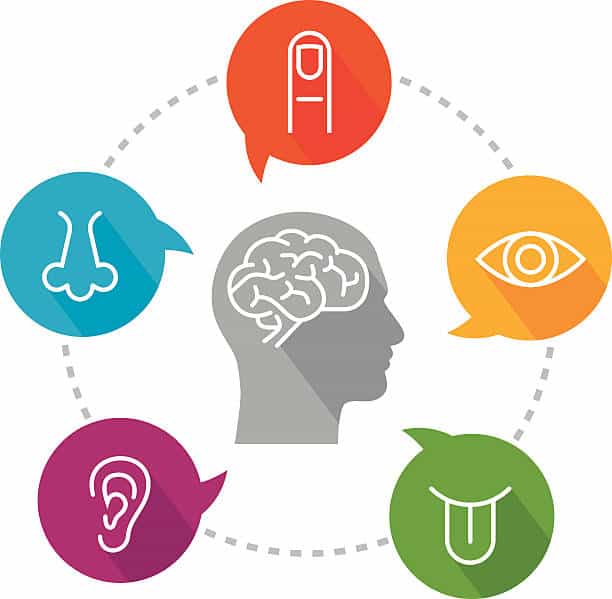No products in the cart.
The Senses in Store Design

When customers walk into a store, all of their senses are engaged. They see the lighting, colors and displays. They hear the type of music or soundscape and its volume and experience its tempo. They smell the ambient scent, product scent, malodors or lack of scent. They feel the store’s temperature and the products themselves. In certain situations, they are able to taste food samples or giveaway items such as candy.
All of these sensory inputs cause a reaction in terms of behavior (linger time, interacting with products and staff, making a purchase, buying more), store/product evaluation, willingness to pay more or less, and intention to purchase, recommend or revisit the store. Here are some findings from sensory research that impact store design.
Sight
- Shoppers touch more products and look at a display longer when there is brighter lighting. (Summers and Hebert, 2001)
- In a store environment, blue decór encourages longer browsing and increases intent to purchase. (Bellizzi and Hite, 1992)
- Male shoppers evaluate products as having a higher perceived value when prices were printed in red compared to black (Puccinelli, Chandrashekaran, Grewal, & Suri, 2013)
- Customers evaluate a store more positively when sales staff facial expressions mirrored their own. When customers are feeling serious and cheerful salespeople approached them, customers are less willing to pay. (Chartrand & Bargh, 1999; Puccinelli et al., 2013)
- People who like strong coffee will drink more coffee when there is bright lighting; people who prefer weaker coffee will drink more of it with dimmer lighting. (Gal, Wheeler and Shiv, 2007)
- For product colors and product packaging, customers prefer blue for functional products and a distinct color for more sensory or social products. (Bottomley and Doyle, 2006)
- Bright orange is associated with lower priced products (ex. Big Lots) and black is associated with more expensive products (ex. Sharper Image). (Jacobs et al., 1991)
Sound
- Customers perceive jewelry stores more positively when they play classical music compared to no music. (Grewal, Baker, Levy and Voss, 2003)
- Louder music played in a supermarket results in shopper spending less time in the store but spending the same amount and having the same customer satisfaction as lower volume music. (Smit and Curnow, 1966)
- Music helps shoppers make easy decisions but interferes with more complex decision making. (Park and Young, 1986)
- Music associated with those who are wealthier and better educated (ex. classical compared to contemporary hits) increases sales in a wine store and a restaurant. (Areni and Kim, 1993; North, Shilcock and Hargreaves, 2003))
- Playing French music in a supermarket results in increased sales of French wine. (North, Hargreaves and McKendrick, 1997)
- Slower tempo music in a supermarket causes customers to spend longer in the aisles and spend more.
Scent
- Scent increases purchase intention and willingness to pay a higher price. (Hirsch, 1990; Miller, 1991)
- Scent increases linger time in a jewelry store (Lipman, 1990)
- Scent increases recall of both products and stores (Krishna, Lwin and Morrin, 2010)
- Gender congruent scents increase sales in the men’s and women’s departments of a department store; sales decreased when the scents were switched. (Spangenberg, Sprott, Grohmann and Tracy, 2006)
- The smell of a recognizable cleaning product causes restaurant patrons to be neater when eating. (Liljenquist, Zhong and Galinsky, 2010)
- Some smells, such as citrus and rose jasmine, cause shoppers to evaluate shampoo as being more silky. (Churchill, Meyners, Giffiths and Bailey, 2009)
Touch
- Customers are more likely to buy a product when they have touched it or picked it up. They may also be more willing to pay more for it. (Grohmann, Spangenberg and Sprott, 2007; Martin, 2013)
- Colder store temperature leads to more emotional decision making and preference for more pleasurable or luxury items. Warmer stores encourage more logical decision making and preference for practical items. (Hadi, Block and King, 2013)
- Lighter colors are associated with smoothness, softness and roundness compared to darker colors. (Ludwig and Simner, 2013)
Taste
- When tasting two things, customers prefer the last option when both are considered desirable/expensive, but the first option when they are both considered less desirable/budget products. (Biswas, Grewal and Roggeveen, 2010)
Multi-sensory Store Design
- When scent and music are compatible in terms of arousal potential (stimulating scent paired with up-tempo music or relaxing scent with slower music), customers consider the store environment to be better, interact with more products and sales staff, increase impulse buying and exhibit more customer satisfaction. (Mattila and Wirtz, 2001)
- The combination of softer lighting and a pleasant scent leads customers to touch products for longer, increases purchase intention and increases sales. (Hultén, 2011)
- When more than one sensory input is present at the same time, it can lead to a superadditive effect where the results are better than the sum of each sensory input on its own. This is more likely when the sensory inputs are weak (lower volume music, less intense scent) and congruent. (Holmes & Spence, 2005)
These are important guidelines to keep in mind for your store design, whether designing a new store or redesigning an existing store. Your Air Esscentials rep can help you integrate scent into your store’s sensory strategy.
Quick Links
More
Sign up for our newsletter!
Contact Information
-
1800 NW 96th Avenue, Doral, FL 33172
-
[email protected]
-
305.446.1670
Office Hours
-
Monday to Thursday: 9 A.M. to 5 P.M. EST
-
Friday: 9 A.M. to 4 P.M. EST
-
Saturday & Sunday: Closed




Copyright © Airesscentials. All rights reserved.
